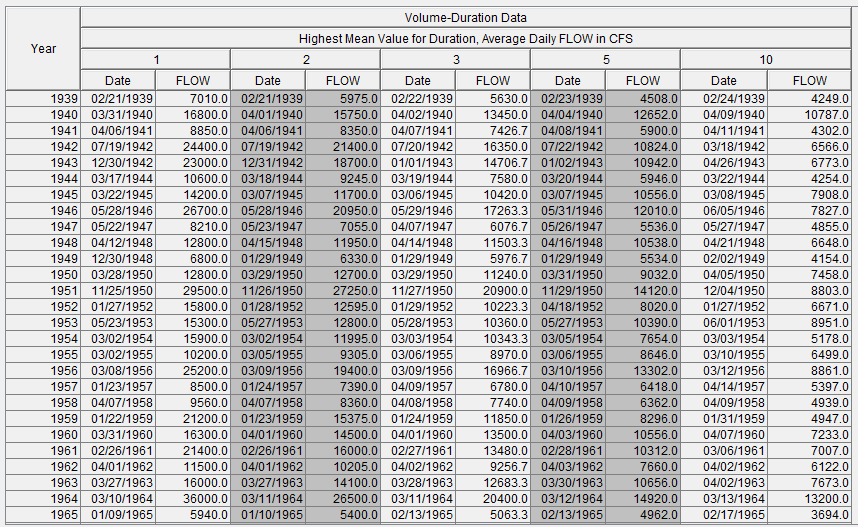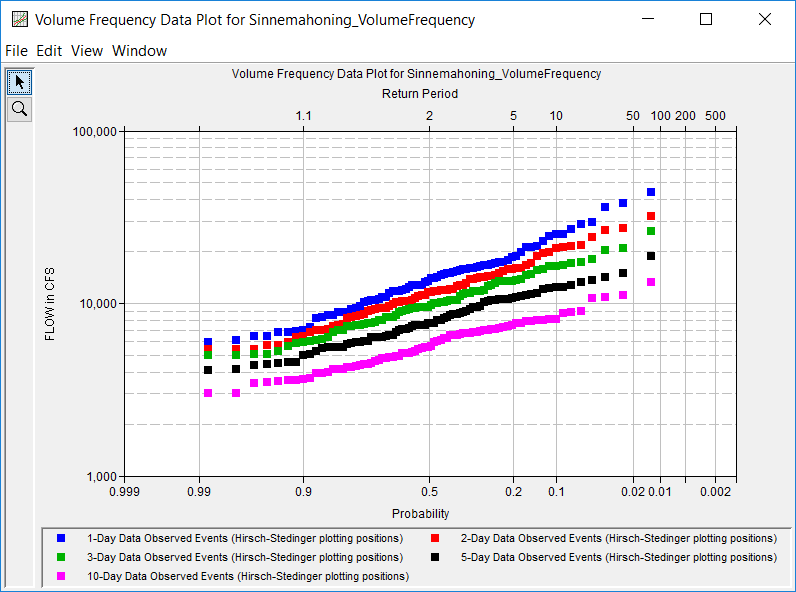The user can extract the volume-duration data once settings have been defined on the General and Options tabs. When the Duration Table tab is selected, the Volume Frequency Analysis editor will appear as shown in Figure 1. The program will compute the annual maximum or minimum average flows for the durations specified on the Options tab when the user presses the Extract Volume-Duration Data button at the top of the Duration tab.

The program computes the maximum/minimum flows for each water year by evaluating the flow record as one continuous record. First, the program computes a time-series of average flow for the durations specified on the Options tab. These time-series are written to the study DSS file and can be viewed using HEC-DSSVue. Then, the program extracts the annual maximum/minimum flows for each duration based upon the Year Specification and, if specified, the Season Start/End the on the General tab and populates the duration table.
When starting a new analysis, the volume-duration duration data will be automatically extracted for the default durations. If the Maximum/Minimum Analysis, Year Specification, or Time Window Modification options on the General tab or the Flow Durations on the Options tab are changed after the volume-duration data has been extracted, a red warning message will be shown near the top of the editor. Also, the Extract Volume-Duration Data button will be highlighted in red. Clicking this button to re-extract the volume-duration data will remove the red warning message and reset the button, shown below.

The Allow Editing checkbox in the upper left portion of the Duration Table tab allows the user to manually edit values in the volume-duration table. The table becomes editable when the Allow Editing box is checked. The user may then overwrite the extracted volume-duration data. If the Allow Editing box is checked, the program will no longer extract annual maxima from the selected data set when the compute button is pressed. Instead, the specified values within the table will be used.
When computing the analysis, the program will issue a warning message if any of the maxima/minima occur a specific number of days after the beginning of the Year Specification date. The number of days is determined by the duration plus five days. For example, for a 15-day duration, the program issues a warning if any of the maxima/minima is within twenty days after the beginning of the Year Specification date. If water year is chosen as the Year Specification date, then the program issues a warning if any of the maxima/minima occurs between October 1 – October 20. This warning is an attempt to let the user know if a specific maximum or minimum flow is generated by an event that began in the previous year. The goal is to prevent a scenario in which the same flow event causes maxima/minima flows in consecutive years.
The user must Compute the analysis before viewing a frequency plot of the volume-duration data. The plot created by pressing the Plot Duration Data button, located at the bottom of a Volume Frequency Analysis editor, shows the annual maxima/minima plotted using the user specified plotting position method, as shown in Figure 2.
